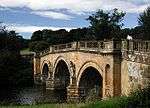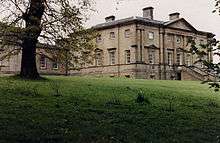James Paine (architect)
| James Paine | |
|---|---|
| Born |
late 1717 Andover, Hampshire |
| Died |
Autumn 1789 France |
| Nationality | English |
| Occupation | Architect |
| Buildings |
Nostell Priory Heath House Kedleston Hall Chatsworth House Worksop Manor Hickleton Hall |
James Paine (1717–1789) was an English architect.
Essentially a Palladian, early in his career he was Clerk of Works at Nostell Priory, and worked on many other projects in the area including Heath House in the village of Heath in between Nostell Priory and Wakefield.
From the 1750s, he had his own practice, and designed many villas, usually consisting of a central building, often with a fine staircase, and two symmetrical wings. The most important house which he was involved with was Kedleston Hall, Derbyshire where he succeeded Matthew Brettingham from 1759 to 1760 and suggested the colonnaded hall, but he was himself displaced by Robert Adam, who altered his designs.
At around the same time he designed the very grand stables at Chatsworth House in the same county. He was a favourite architect of the powerful Catholic families of the time. In the 1760s he was commissioned to rebuild Worksop Manor for the Duke of Norfolk as well as the new Thorndon Hall (1764–70) in Essex for Lord Petre and his house on Park Lane, London. From 1770 to 1776, he built New Wardour Castle in Wiltshire (which featured as the Royal Ballet School in the film Billy Elliot).
Paine held various posts, some sinecures, in the Office of Works culminating in appointment as one of the two Architects of the Works in 1780 but lost the post in a reorganisation in 1782. He was appointed High Sheriff of Surrey for 1783.
His practice declined in his later years as he refused to participate in the Neoclassical fashions established by the Adam brothers. He published much of his own work in his two volumes of Plans, elevations and sections of Noblemen and Gentlemen's Houses (1767 and 1783).
His son James Paine (1745–1829) was a sculptor.[1]
List of architectural works
The following are major works attributed to Paine:[2]

- Nostell Priory, Yorkshire (c.1737–50) interiors completed and new wing added later by Robert Adam
- Heath House, Yorkshire (1744–45)
- 17 Cornmarket, Pontefract, Yorkshire, attributed (c.1745–50)
- Hickleton Hall, Yorkshire, house and attributed stables (1745–49)
- Mansion House, Doncaster (1745–48), which is one of only three civic mansion houses in England.
- Cusworth Hall, Yorkshire, wings (1749–53)
- Wilsford Manor, Lincolnshire, additions (1749) demolished
- Wadworth Hall, Yorkshire (c.1749–50)
- 5 Market Place, Pontefract, Yorkshire, attributed (c.1750–55)
- High Melton Hall, Yorkshire, attributed (c.1750)
- Sprotbrough Hall, Yorkshire, un specified work (c.1750)
- Milnsbridge Hall, Milnsbridge, Yorkshire, attributed (c.1750)
- Bierley Hall, Yorkshire, alterations and interiors (c.1750) demolished
- The Biggin, Bramham cum Oglethorpe, Yorkshire, alterations (c.1750–56)
- Old Deanery, York, alterations (c.1750)
- Ormsby Hall, South Ormsby, Lincolnshire (1750–56)
- Felbrigg Hall. Norfolk, new service wing, internal decoration of main rooms (1751–56)
- Dinnington Hall, Dinnington, Yorkshire, attributed, wings (c.1751–57)
- Kirkstall Grange, Headingley, Yorkshire (1752)
- 76 St. Martin's Lane (Paine's own home) and Little Court, Castle Street, London (1752–54) demolished
- Cowick Hall, Yorkshire, external and internal alterations (1752–60)
- Whitley Beaumont, Yorkshire, redecoration of great hall and attributed gazebo (c.1752–54) demolished
- Blagdon Hall, Northumberland, new stables (1753–56)
- Northumberland House, London, picture gallery (c.1753–57) demolished
- Raby Castle, County Durham, partial remodelling, interiors, estate cottages and model farm (c.1753–60)
- Gibside, County Durham, interior decoration of house (lost, as house is now a ruin), column of British Liberty and free standing chapel (1753–67)
- Alnwick Castle, Northumberland, reconstruction of keep, interior decoration (c.1754–68) largely destroyed by Anthony Salvin's remodelling in the 19th century
- Coxhoe Hall, Coxhoe, County Durham, external and internal alterations (c.1754) demolished
- 19 St. James's Square, London, remodelling of house (c.1754–60)
- Hardwick, Hardwick, County Durham, various garden buildings (c.1754–57)
- Dover House, Whitehall London (1754–58) subsequently extended most notably by Henry Holland in 1787
- Serlby Hall, Nottinghamshire (1754–73)
- Belford Hall, Northumberland (c.1755–56)
- Wallington Hall, Northumberland, bridge (1755)
- Gosforth House, Gosforth, Northumberland (1755–64)
- Middlesex Hospital, London (1755–78) demolished
- Chatsworth House, Derbyshire, new office wing and court (replaced by Sir Jeffry Wyatville), stable block, bridge in the park, bridge at Beeley, water mill and alterations to interiors of the house (1756–67)
- Norfolk House, London, alterations and repairs (c.1756–69)
- Stoke Hall, Derbyshire, attributed (c.1757)
- Glentworth Hall, Glentworth, Lincolnshire, remodelling and new stables (1757–66) largely demolished
- Ravensworth Castle, County Durham, external and internal alterations (c.1758) demolished 1808 and replaced by John Nash this later house has also been largely demolished
- Cavendish Bridge (Wilne Ferry Bridge), Shardlow, Derbyshire (1758–61)
- Stockeld Park, Spofforth, North Yorkshire (1758–63)
- Axwell House, County Durham (1758)
- Bingley St Ives, Yorkshire (1759)
- Kedleston Hall, Derbyshire (1759–63) replaced Matthew Brettingham only to be replaced for the interiors and south front by Robert Adam
- Bywell Hall, Northumberland (c.1760)
- Brocket Hall, Hertfordshire (c.1760–75) reconstruction of house, park lodges, bridge and probably the stables
- Bramham Park, Yorkshire, attributed, pavilions each end of the stables and garden temple (c.1760)
- 47 Leicester Square, London gallery and painting room for Sir Joshua Reynolds, attributed (also attributed to William Chambers (architect)) (1760–61)
- Devonshire House, London, internal decoration (1760)
- Worksop Manor, Nottinghamshire (1761–67) demolished
- Forcet Park, Yorkshire, Banqueting House (c.1762) demolished
- Arundel Castle, Sussex, minor repairs (1762)
- 14 Downing Street, London, alterations (c.1763–6) demolished
- Sandbeck Park, Yorkshire remodelling and extension of house, new kitchen and stable blocks and garden buildings (c.1763–68)
- Gopsall Hall, Gopsall, Leicestershire, garden temple (c.1764)
- The Duke of Norfolk's Palace, Norwich, Roman Catholic Chapel and priest's house (c.1764) demolished
- Thorndon Hall, Essex (1764–70)
- 77–78 Strand, London (1765–73) demolished
- Weston Park, Staffordshire, chimneypieces and attributed interior decoration (c.1765–66), bridge and temple of Diana (c.1770)
- Lumley House, South Audley Street, London, alterations (1766)
- 17 St. James's Square, London, chimneypiece (1766)
- Lord Petre's House, Park Lane, London (1766–70) demolished
- Melton Constable Hall, Melton Constable, Norfolk,attributed, chimneypieces (c.1767)
- North End House and adjoining house, Hampstead, Middlesex (1767)
- St Paul's Walden Bury, Hertfordshire, attributed, north range (1767)
- Burton house, Lincolnshire, alterations, new front range, stables and service building (1767–71)
- Britwell house, Britwell Salome, Oxfordshire, attributed, chapel ceiling (c.1768)
- Hare Hall, Romford, Essex (1768–70)
- 79 Pall Mall, London (1769–71) demolished
- Shrubland Park, Suffolk (c.1769–72) later remodelled by Sir Charles Barry
- 28 Sackville Street, London, chimneypiece (c.1770)
- Moor Park, Surrey, attributed, remodelling (c.1770–75)
- Bagshot Park, Surrey, remodelled and interiors (1770–72), rebuilt 1877 by Benjamin Ferrey
- Cowick Hall, significantly remodelled and added a gatehouse and stables (1752–1760)
- Chillington Hall, Staffordshire, bridge (c.1770) and Gothic & Grecian temples (1772–73)
- St. Anne's Soho Parish Workhouse, London (1770–71)
- Wardour Castle, Wiltshire (1770–76)
- 59 Strand, Coutts Bank, London, alterations (1770–71) & (1781–83) demolished
- Gaines Hall, Upminster, Essex (1771–76)
- Academy & Exhibition Rooms for the Society of Artists, Strand London (1771–72) demolished
- Sayes Court, Surrey, alterations (c.1773)
- Melbourne House, London, Chimneypieces (1773)
- 37 King Street, Covent Garden, London (1773–74)
- Hill House, Hampton, Middlesex, alterations (1774–75)
- Richmond Bridge, London (1774–77)
- 105 Pall Mall, London, alterations (1779–81) demolished
- Chertsey Bridge, Surrey (c.1780–85)
- Kew Bridge, Surrey, replacement of original bridge, joint work with Paine's son (1783–89) replaced by new bridge c.1903
- Walton Bridge, Surrey, second bridge (c.1783) rebuilt
- Middleton Lodge, Middleton, West Yorkshire[3]
Gallery of architectural works
 Chatsworth, Derbyshire, stables
Chatsworth, Derbyshire, stables New Wardour Castle, Wiltshire
New Wardour Castle, Wiltshire- Thorndon Hall, Essex
 Nostell Priory, Yorkshire
Nostell Priory, Yorkshire Kedleston Hall, Derbyshire, north front
Kedleston Hall, Derbyshire, north front Gibside Chapel, County Durham
Gibside Chapel, County Durham- Gibside, Column of British Liberty
 Entrance front, Brocket Hall
Entrance front, Brocket Hall Cusworth Hall, the wings are by Paine
Cusworth Hall, the wings are by Paine Chertsey Bridge, Surrey
Chertsey Bridge, Surrey Stockeld Park, Yorkshire
Stockeld Park, Yorkshire- Worksop Manor, Nottinghamshire, demolished
 Bridge over the Derwent, in the Park, Chatsworth House, Derbyshire
Bridge over the Derwent, in the Park, Chatsworth House, Derbyshire Belford Hall, Northumberland
Belford Hall, Northumberland- Mansion House, Doncaster, Yorkshire
- Richmond Bridge, Richmond, London
References
Notes
- ↑ 'Paine, James', in Robert Gunnis, ed., Dictionary of British Sculptors 1660–1851
- ↑ pages 171 to 217, James Paine, Peter Leach, 1988, A. Zwemmer Ltd
- ↑ Middleton Lodge, leodis.net, retrieved 2 December 2009
Bibliography
- H.M. Colvin, A Biographical Dictionary of British Architects, 1600–1840 (1997) ISBN 0-300-07207-4
| Wikimedia Commons has media related to James Paine. |